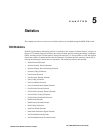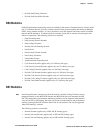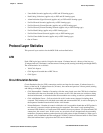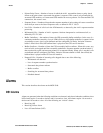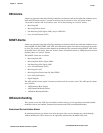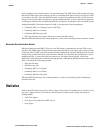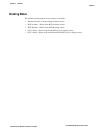
5-3
Cisco MGX 8240 Hardware User’s Guide
Release 3.0, Part Number 78-10728-01, July 2000
Chapter 5 Statistics
Protocol Layer Statistics
• Unavailable Seconds (applies only to ESF and SF framing types)
• Path Coding Violations (applies only to ESF and SF framing types)
• Alarm Indication Signal Seconds (applies only to ESF and SF framing types)
• Far End Errored Seconds (applies only to ESF framing type)
• Far End Severely Errored Seconds (applies only to ESF framing type)
• Far End Severely Errored Framing Seconds (applies only to ESF framing type)
• Far End Path Coding (applies only to ESF framing type)
• Far End Line Errored Seconds (applies only to ESF framing type)
• Far End Unavailable Seconds (applies only to ESF framing type)
• Out-of-Frame
Protocol Layer Statistics
This protocol layer statistics for the MGX 8240 are described below.
ATM
Each ATM logical port statistic is kept for the current 15-minute interval, a history of the last two
15-minute intervals (30 minutes), and the current 24-hour period (starting and ending at midnight GMT).
The ATM statistics are as follows:
• Valid Cells Ingress
• Cells Ingress discarded due to HEC Errors
• Cells Egress
Circuit Emulation Service
Circuit Emulation Service (CES) connection statistics are kept for the current 15-minute interval, a
history of the last 96 15-minute intervals (24 hours), the current and previous 24-hour period (starting
and ending at midnight GMT).
• Cells Reassembled—Number of incoming cells that were played out to the CES Service interface.
It excludes cells that were discarded for any reason, such as cells that were not used due to being
declared misinserted, or discarded while the reassembler was waiting to achieve synchronization.
• Cells with Header Errors—Cells received with AAL1 header errors detected, including those
corrected. This includes cells with both correctable and uncorrectable CRC, as well as bad parity in
the Sequence Number Protection field of the AAL1 header.
• Pointer Reframes—Number of events in which the AAL1 reassembler found that an SDT pointer is
not where it is expected, and the pointer must be reacquired. This count is only meaningful for
structured CES modules, as Unstructured CES modules do not use pointers. For Unstructured CES
connections, this count is zero. If this occurs, any received cells are dropped until the reassembly
underflows. Sequence number synchronization and valid pointer is then searched for. When sync is
reached, cells are buffered until the configured Cell Delay Variation Tolerance buffer is filled. Once
filled, the buffered data is played out the CES service interface.



